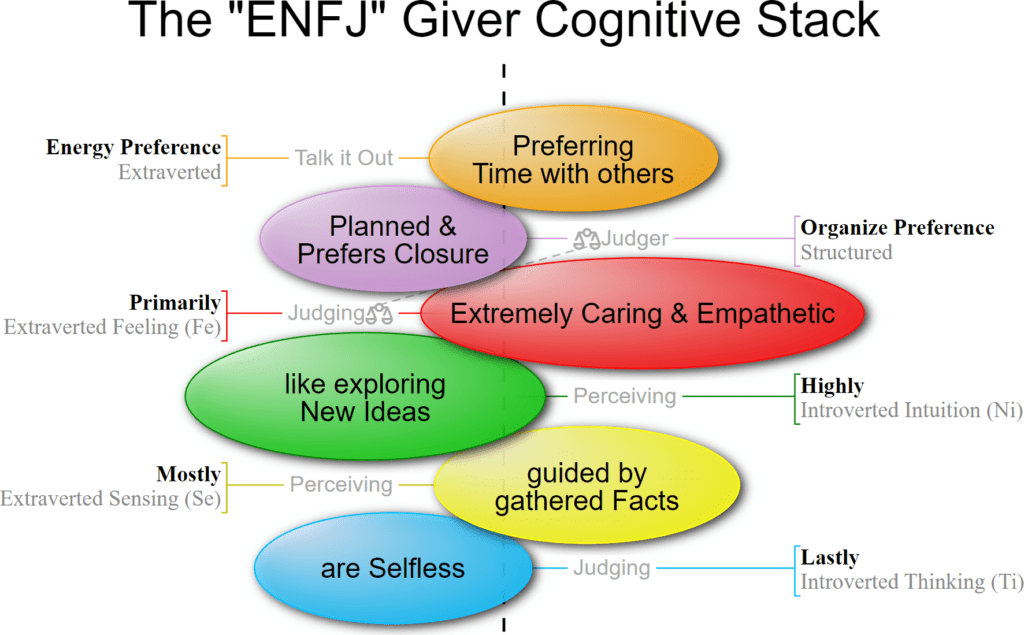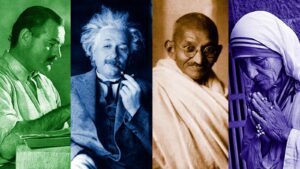What is the Keirsey ENFJ “Teacher” Personality Type?
The Keirsey ENFJ “Teacher” Personality Type is an Idealist Temperament with an Abstract Communication Style and a Cooperative Action Style.
Keirsey organized the Four Temperaments as a matrix. There are two communication styles, abstract and Concrete, similar to the Myers-Briggs Intuition (Abstract) and Sensing (Concrete) “Perceiving” Cognitive Functions.
And by two action styles: Cooperative and Utiltarian. Utilitarian people, for the most part, do what works, while Cooperative people do what’s right.
Keirsey named the Four Temperaments as suggested by Plato: Artisan (Iconic), Guardian (Pistic), Idealist (Noetic), and Rational (Dianoetic).

Concrete versus Abstract Communication Style
Keirsey divided the Four Temperaments into two Communication Styles: Abstract and Concrete. These styles resemble the Myers-Briggs Intuition and Sensing “Perceiving” Cognitive Functions.
Some people talk primarily about everyday reality’s external, concrete world: facts and figures, work and play, home and family, news, sports, and weather—all the who, what, when, where, and how of life.
Other people talk primarily about the internal, abstract world of ideas: theories and conjectures, dreams and philosophies, beliefs and fantasies—all the whys, ifs, and what might be of life.
Concrete people talk about reality in their daily lives, while Abstract people talk about ideas.
According to Keirsey, everyone can engage in both observation and introspection. People are observant when they touch objects or otherwise perceive the world through their five senses.
When people reflect and focus on their internal world, they are introspective. However, individuals cannot engage in observation and introspection simultaneously. The extent to which people are more observant or reflective affects their behavior.
People who are generally observant are more ‘down to earth.’ They are more concrete in their worldview and focus on practical matters such as food, shelter, and their immediate relationships. Carl Jung used the word sensation when describing people who prefer concrete perception.
Generally, reflective people have more ‘heads in the clouds’ and abstract worldviews. They focus on global or theoretical issues such as equality or engineering. Carl Jung used the word intuition to describe people who prefer abstract perception.
Cooperative versus Utilitarian Action Style
Some people act primarily practically or pragmatically; that is, they do what gets results, what achieves their objectives as effectively or efficiently as possible. They only check afterward to see if they observe the rules or go through the proper channels.
Other people act primarily cooperatively or socially acceptable; they try to do the right thing in keeping with agreed-upon social rules, conventions, and codes of conduct. Only later do they concern themselves with the effectiveness of their actions.
These two ways of acting can overlap, but as they lead their lives, Utilitarian people mostly do what works, while Cooperative people do what’s right.
Keirsey compares the differing temperaments with cooperative (Complying) and pragmatic (Adaptive) temperaments. Cooperative people pay more attention to other people’s opinions and are more concerned with doing the right thing. Sensible people (Utilitarian) pay more attention to their thoughts or feelings and are more concerned with doing what works. No comparable idea in the MBTI or Jung corresponds to this dichotomy, which is a significant difference between Keirsey’s work and Myers and Jung’s.
The pragmatic temperaments are Rational (pragmatic and abstract) and artisan (Pragmatic and concrete). The Cooperative Temperaments are Idealists (Cooperative and Abstract) and Guardians (Cooperative and Concrete). Neither the MBTI nor Jung included the concept of Temperament in their work.
ENFJ Keirsey/MBTI Correlation
| Keirsey | MBTI | |
|---|---|---|
| E | Attentive Role Variant | Extraverted Feeling |
| N | Abstract Communication Style | Introverted iNtuition Auxiliary Function |
| F | Cooperative Action Style | Extraverted Feeling Dominate Function |
| J | Directive Role | The feeling is a Judging Function |
With Introverted Intuition as the first Dominant Function and Extraverted Thinking as the second Auxiliary Function, the MBTI ENFJ “Giver” Personality Type sorts to the Keirsey ENFJ “Teacher” Personality Type.

ENFJ Personality Type cross-reference
- Keirsey Type – Teacher
- Temperament Type – Phlegmatic
- Animal Type – Otter
- DISC Type – Influential
- Socio-Communicative Type – Expressive
- True Colors – Blue
- Color Code – Blue
- Personality Compass – West
- Occupational Type – Artistic
- Learning Type – Theorist
- Leadership Type – Collaborator
Enneagram Types
Teacher Personality Characteristics
Even more than the other Idealists, Teachers have a natural talent for leading students or trainees toward learning, or as Idealists like to think of it, they can call forth each learner’s potential.
Teachers (around two percent of the population) seem to effortlessly and almost endlessly dream up fascinating learning activities for their students. In some Teachers, this ability to fire the imagination can amount to a genius that other types find hard to emulate.
However, perhaps their greatest strength lies in their belief in their students.
Teachers look for the best in their students and communicate clearly that each one has untold potential. This confidence can inspire their students to grow and develop more than they ever thought possible.
Teachers consider people their highest priority in whatever field they choose, and they instinctively communicate personal concern and a willingness to become involved.
Warmly outgoing and perhaps the most expressive of all the types, teachers are remarkably good with language, especially when communicating in speech and face-to-face. And they do not hesitate to speak out and let their feelings be known.
Bubbling with enthusiasm, Teachers will voice their passions with a dramatic flourish and can, with practice, become charismatic public speakers.
This verbal ability gives Teachers a lot of group influence, and they take a leadership role.
Teachers who like things settled and organized will schedule their work hours and social engagements well ahead of time and are trustworthy in honoring these commitments.
Valuing as they do interpersonal cooperation and harmonious relations, teachers are extraordinarily tolerant of others, easy to get along with, and usually popular wherever they are.
Teachers are highly sensitive to others, so their intuition tends to be well-developed. Indeed, their insight into themselves and others is unparalleled.
They know what is happening inside themselves and can read other people with uncanny accuracy.
Teachers also identify with others quite quickly and will find themselves picking up the characteristics, emotions, and beliefs of those around them.
Because they slip almost unconsciously into other people’s skin in this way, Teachers feel closely connected with those around them and thus show a sincere interest in the joys and problems of their employees, colleagues, students, clients, and loved ones.
Famous Teachers
Mikhail Gorbachev, Oprah Winfrey, Pope John Paul II, Ralph Nader, John Wooden, and Margaret Mead are examples of Teacher Idealists.

What are the Keirsy Personality Temerpaments?

David Keirsey, born in 1921, was an American psychologist specializing in conflict management and family counseling. He began researching human behavior and Personality in the 1940s.
Keirsey blended the Myers-Briggs Personality Types with Ernst Kretschmer’s model of the Four Temperaments, developing the Keirsey Temperament Sorter, which was made famous by his book “Please Understand Me.”
Instead of using the term Personality, Keirsey used Temperament. He viewed it as a configuration of observable Personality Traits, communication habits, patterns of action, characteristic attitudes, values, and talents. To Keirsy, Temperament encompasses personal needs, individual contributions, workplace contributions, and societal roles.
Keirsey correlated the sixteen MBTI Personality Types into Four Temperaments. He divided each Temperament into two Roles: informative and Directive. He subdivided the roles into expressive (extraverted) and attentive (introverted) role Variables.
Informative versus Directive Roles
Keirsey distinguishes between people who generally communicate by informing others versus those who speak by directing others. This distinction subdivides each of the four Temperaments into eight Roles.
Expressive versus Attentive Role Variants
Individuals who act before observing are Expressive. In contrast, people who follow before working are Attentive.
Expressive and attentive variants further subdivide the eight roles into 16 types correlating to the 16 Myers-Briggs personality types.


